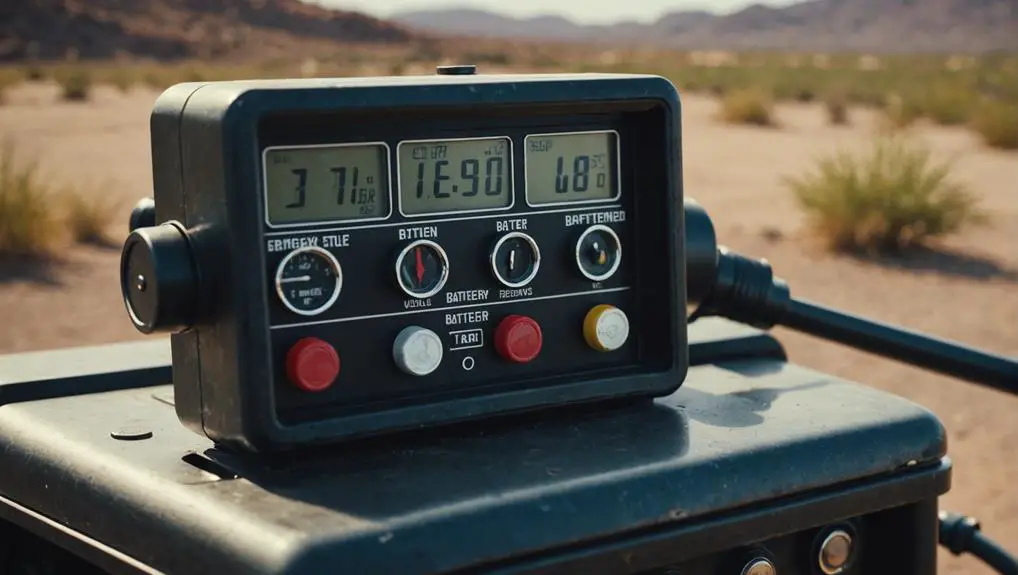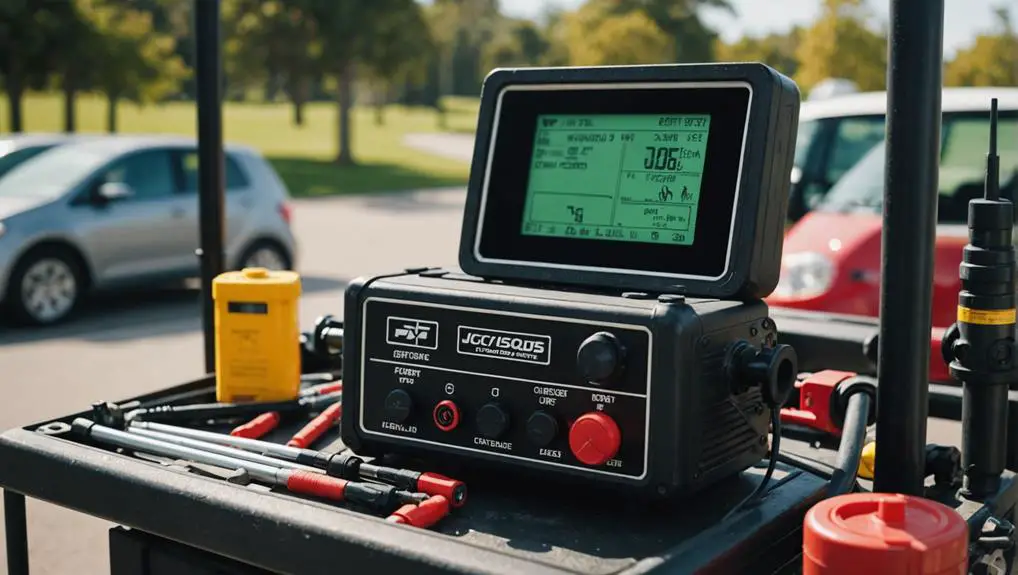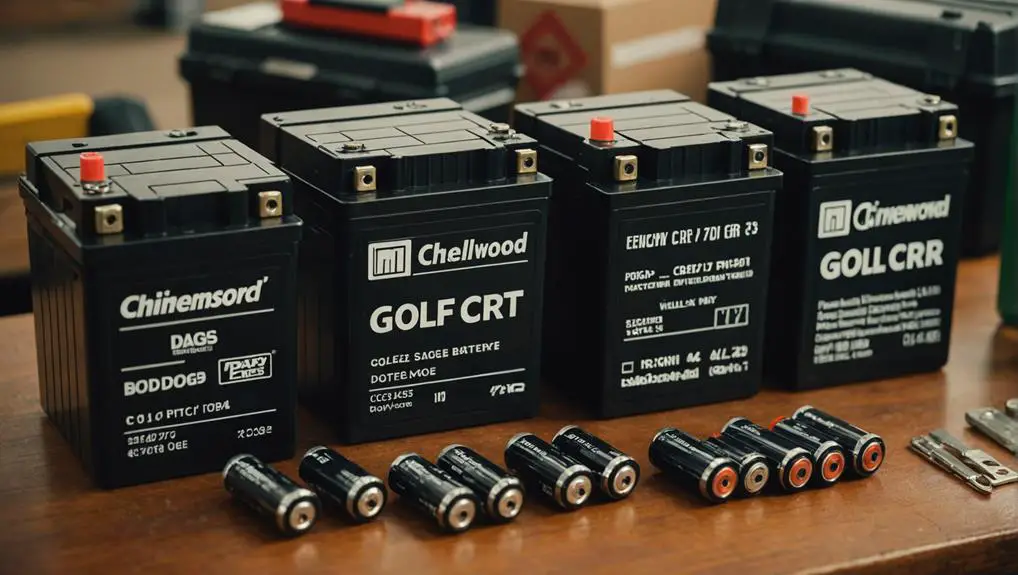When you think about how long golf cart batteries last, you might find the answer isn't as straightforward as you'd expect. Typically, lead-acid batteries can serve you for about 4 to 6 years, while lithium-ion options might last even longer. However, the real question lies in what factors can truly impact that lifespan. Are your charging habits up to par? What about maintenance? Understanding these elements could be the key to maximizing the longevity of your battery, but there's more to reflect on before deciding on the best approach.
Key Takeaways
- Lead-acid batteries typically last 4 to 6 years, while lithium batteries can exceed 7 to 10 years.
- Regular charging and proper maintenance significantly enhance battery lifespan and performance.
- Driving conditions and usage patterns, like terrain and load, impact battery longevity.
- AGM batteries are maintenance-free, offering longer lifespan and better performance than traditional flooded lead-acid batteries.
- Environmental concerns arise from battery production and disposal; recycling programs help mitigate these impacts.
Average Lifespan of Batteries
Understanding the average lifespan of golf cart batteries is vital for maximizing their performance and longevity. Typically, you can expect lead-acid batteries to last between 4 to 6 years, while lithium batteries may stretch that to 7 to 10 years or more.
However, several factors influence these averages.
First, consider how often you charge the batteries. Regular charging after each use helps prevent deep discharges, which can greatly shorten battery life. It's also important to avoid overcharging, as this can damage the cells.
Next, examine the maintenance practices you employ. For lead-acid batteries, regularly checking water levels and cleaning terminals can enhance lifespan. On the other hand, lithium batteries require minimal maintenance but should be kept within the recommended temperature ranges to avoid performance issues.
Lastly, the conditions in which you operate your golf cart play a role. Frequent short trips may lead to incomplete charging cycles, while extreme temperatures can affect battery chemistry.
Types of Golf Cart Batteries
When choosing a golf cart battery, you'll typically encounter lead-acid and lithium-ion options, each with distinct advantages.
Understanding the performance, maintenance requirements, and lifespan factors of these batteries will help you make an informed decision.
Let's explore how these types of batteries can impact your golf cart's efficiency and longevity.
Lead-Acid Battery Overview
The durability and performance of golf cart batteries are heavily influenced by their type, with lead-acid batteries being the most common choice.
These batteries come in two main varieties: flooded and sealed (AGM or gel). Flooded lead-acid batteries require regular maintenance, including checking electrolyte levels and adding distilled water. They offer high discharge rates and are often more cost-effective, but you must guarantee they're properly ventilated to avoid gas buildup during charging.
On the other hand, sealed lead-acid batteries, such as AGM (Absorbent Glass Mat) and gel batteries, are maintenance-free and can be installed in any position. AGM batteries provide better vibration resistance and a longer lifespan compared to flooded types. Gel batteries are less susceptible to extreme temperatures but may have lower discharge rates.
When choosing a lead-acid battery for your golf cart, consider factors like capacity, discharge rates, and maintenance requirements.
Proper charging practices are essential for maximizing their lifespan. Regularly monitoring voltage and making sure you don't over-discharge the batteries will help maintain their performance.
Lithium-Ion Battery Benefits
In contrast to lead-acid batteries, lithium-ion batteries offer several advantages that make them an increasingly popular choice for golf carts.
One key benefit is their higher energy density, which means they store more energy in a smaller, lighter package. This can greatly reduce the overall weight of your golf cart, enhancing its performance and efficiency.
Lithium-ion batteries also provide a longer lifespan, typically lasting up to 4-5 times longer than traditional lead-acid batteries. This longevity translates to fewer replacements, saving you money in the long run. Additionally, they charge faster, allowing you to get back on the course without long wait times.
Another advantage is their ability to maintain consistent power output throughout the discharge cycle. This means you won't experience the voltage drop that often occurs with lead-acid batteries, ensuring a more reliable performance on the course.
Moreover, lithium-ion batteries are more environmentally friendly, as they contain no toxic materials and are easier to recycle.
Maintenance and Lifespan Factors
Understanding the maintenance and lifespan factors of different types of golf cart batteries is crucial for maximizing their performance. Golf cart batteries mainly fall into two categories: lead-acid and lithium-ion.
Lead-acid batteries, though cost-effective, require regular maintenance. You should check the water levels frequently, confirming the plates are submerged, and clean any corrosion from terminals to maintain peak conductivity.
On the other hand, lithium-ion batteries are low-maintenance but still demand attention. You must periodically check the battery management system to verify it's functioning correctly and keep the terminals clean.
Temperature also plays a critical role. Extreme heat can accelerate degradation in lead-acid batteries, while lithium-ion batteries perform best in moderate conditions.
Charging habits greatly influence lifespan, too. Full discharges can shorten a lead-acid battery's life, so aim to recharge when they reach about 50% capacity. For lithium-ion, avoid letting them drop below 20%.
Lastly, consider the depth of discharge; smaller, more frequent charges are generally better than deep discharges. By following these maintenance practices, you can greatly extend the lifespan of your golf cart batteries, confirming reliable performance for years to come.
Factors Affecting Battery Life

Battery longevity hinges on several essential factors that influence performance and lifespan.
First, the type of battery you choose plays a considerable role. Lead-acid batteries are cheaper but typically last 3-5 years, while lithium-ion batteries can endure up to 10 years.
Next, temperature affects battery efficiency. Extreme heat can accelerate the degradation process, while cold temperatures can reduce capacity. Ideally, you should store your golf cart in a climate-controlled environment to mitigate these effects.
Charging habits also impact battery life. Overcharging or undercharging can lead to sulfation in lead-acid batteries, shortening their lifespan. To maintain peak performance, use a smart charger that prevents overcharging and guarantees the battery is fully charged without damaging it.
Additionally, the quality of water used in maintenance is vital for flooded lead-acid batteries. Using distilled water prevents mineral buildup and corrosion, which can impair battery function.
Lastly, the age of the battery when purchased matters. Older batteries may have diminished capacity even if they appear new, so always check the manufacturing date.
Usage Patterns and Impact
Your golf cart's usage patterns greatly influence battery life and performance.
Understanding these patterns can help you optimize battery longevity and efficiency. Here are four key factors to evaluate:
- Frequency of Use: Regular usage can keep the battery charged and help maintain its health. Infrequent use can lead to deeper discharges and reduced lifespan.
- Terrain: Driving on hilly or uneven terrain increases the strain on the battery. This can lead to quicker depletion and overheating.
- Speed and Acceleration: Frequent rapid acceleration and high-speed travel can draw more power, causing faster battery drain.
- Load Weight: Carrying heavy loads or multiple passengers puts additional strain on the battery, decreasing its overall life.
Importance of Regular Maintenance

To maximize your golf cart battery's lifespan, regular maintenance is crucial.
You should implement battery cleaning techniques to remove corrosion and guarantee peak performance, while also conducting regular inspections to identify potential issues before they escalate.
Battery Cleaning Techniques
Maintaining clean battery terminals is essential for ideal performance and longevity of golf cart batteries.
Dirty terminals can lead to poor electrical connections, reducing efficiency and lifespan. Here are four effective battery cleaning techniques:
- Safety First: Always wear gloves and safety goggles. Disconnect the battery cables, starting with the negative terminal, to prevent any short circuits.
- Inspect for Corrosion: Check for white, ashy deposits (corrosion) on the terminals. This buildup can hinder performance, so you'll want to remove it.
- Cleaning Solution: Mix a solution of baking soda and water (1:1 ratio). Apply it to the terminals with a toothbrush or soft brush, scrubbing gently to dissolve corrosion.
- Rinse and Dry: After cleaning, rinse the terminals with clean water to remove any residue.
Dry them thoroughly with a cloth to prevent moisture buildup, which can cause further corrosion.
Regular Inspection Benefits
How often do you inspect your golf cart batteries? Regular inspections are essential for maintaining battery health and guaranteeing peak performance. By checking your batteries every month, you can identify issues early, preventing costly repairs or replacements down the line.
During your inspections, look for signs of corrosion on terminals and verify connections are tight. Loose or corroded connections can lead to poor performance and decreased battery life.
Also, inspect the water levels in the battery cells; underfilled batteries can suffer from sulfation, which permanently affects capacity. If levels are low, refill with distilled water to the recommended height.
Don't forget to check for physical damage as well. Cracks or leaks can indicate severe issues that need immediate attention.
Testing the voltage with a multimeter is also a great practice. If you notice a significant drop in voltage, it might signal that your batteries need recharging or are nearing the end of their lifespan.
Signs of Battery Wear
Recognizing the signs of battery wear can help you avoid unexpected breakdowns on the course. If you know what to look for, you can take action before it's too late.
Here are four key indicators of battery deterioration:
- Decreased Performance: If your golf cart struggles to maintain speed or power, it's a clear sign that the battery might be losing its capacity.
- Swelling or Bulging: Physical changes in the battery casing, like swelling or bulging, indicate internal damage and can lead to failure.
- Corrosion: Check the battery terminals for any signs of corrosion, which can impede electrical flow and reduce performance.
- Shorter Run Time: If you notice you're needing to recharge your battery more frequently than before, it's likely nearing the end of its life.
Optimal Charging Practices

To maximize your golf cart batteries' lifespan, establish a regular charging schedule that aligns with your usage patterns.
Avoid deep discharging, as allowing the battery to drain considerably can lead to irreversible damage.
Regular Charging Schedule
Establishing a regular charging schedule is crucial for maximizing the lifespan of your golf cart batteries. Adhering to a consistent routine not only keeps your batteries charged but also helps maintain peak performance.
Here are some key practices to take into account for an effective charging schedule:
- Charge After Each Use: Always recharge your batteries after every outing, even if you think they're still partially charged.
- Use Quality Chargers: Invest in a high-quality charger designed specifically for your battery type to guarantee efficient charging.
- Charge in a Controlled Environment: Whenever possible, charge your batteries in a temperature-controlled space, ideally between 32°F and 100°F (0°C to 38°C). Extreme temperatures can negatively impact battery performance.
- Monitor Charge Levels: Regularly check your batteries' voltage and specific gravity levels to verify they're charging properly and not being overcharged.
Avoid Deep Discharging
Avoiding deep discharging is essential for extending the life of your golf cart batteries. Deep discharging occurs when you drain the battery below its recommended voltage level, typically around 50% of its capacity. Doing this consistently can lead to irreversible damage, reducing the overall lifespan of your batteries.
To prevent deep discharging, monitor your battery's state of charge (SOC) regularly. Utilize a voltmeter or a battery management system to keep track of voltage levels. A fully charged lead-acid battery should measure around 12.6 volts or higher. Avoid letting the voltage drop below 12.0 volts, as this indicates the battery is nearing depletion.
Additionally, establish a habit of recharging your batteries after each use, even if they seem partially charged. This practice minimizes the risk of deep discharging and helps maintain peak performance. If you find yourself frequently using your cart for extended periods, consider investing in a higher-capacity battery or a second set for backup.
Lastly, always use a quality charger specifically designed for your battery type, ensuring that it has features to prevent overcharging and promote balanced cell charging.
Following these practices will greatly enhance your batteries' longevity and efficiency.
Storage Tips for Longevity
Proper storage of golf cart batteries is essential for maximizing their lifespan and guaranteeing peak performance. Following these tips will help you maintain your batteries in prime condition:
- Charge Before Storing: Always charge your batteries to full capacity before storage. This prevents sulfation and keeps the electrolyte levels balanced.
- Store in a Cool, Dry Place: Find a location that's cool and dry, ideally between 32°F and 80°F. Extreme temperatures can damage the battery's internal components and lead to reduced efficiency.
- Check Water Levels: If you have flooded lead-acid batteries, regularly check and top off the water levels with distilled water. This guarantees that the plates remain submerged and prevents deterioration.
- Disconnect and Clean: Disconnect the battery cables to prevent any parasitic drain.
Additionally, clean the terminals with a mixture of baking soda and water to remove any corrosion.
Replacement Options and Costs

When it comes time to replace your golf cart batteries, understanding your options and associated costs is essential for making an informed decision. You typically have three main types of batteries: lead-acid, lithium-ion, and AGM (Absorbent Glass Mat). Each type varies in lifespan, performance, and price.
Lead-acid batteries are the most common and affordable option, usually costing between $800 and $1,200 for a set of six. However, they require regular maintenance and may last around 4 to 6 years.
Lithium-ion batteries are more expensive, ranging from $3,000 to $5,000, but they offer longer lifespans of 10 years or more, faster charging times, and less weight.
AGM batteries fall in between, costing around $1,200 to $2,000 and providing better performance than traditional lead-acid batteries while requiring less maintenance.
When considering replacement, factor in installation costs, which can add an additional $100 to $300.
Remember to evaluate the total cost of ownership, including longevity and maintenance, to find the best option for your golf cart needs.
Environmental Impact on Batteries
The environmental impact of golf cart batteries is a crucial factor for both users and manufacturers. Understanding this impact can help you make informed choices about battery usage and disposal. Here are four key factors to reflect on:
- Material Composition: Many golf cart batteries contain lead, which poses significant environmental hazards if not disposed of properly.
- Recycling Options: Recycling programs exist for lead-acid batteries, allowing you to reduce landfill waste and reclaim valuable materials.
- Life Cycle Emissions: The production, usage, and disposal stages of battery life contribute to greenhouse gas emissions, impacting air quality and climate change.
- Battery Disposal: Improper disposal can leak toxic substances into the environment, harming ecosystems and human health.
To minimize your environmental footprint, you should choose batteries with longer lifespans and explore eco-friendly alternatives like lithium-ion batteries.
Additionally, always follow local regulations for battery disposal and recycling. By being proactive, you can help mitigate the environmental effects of golf cart batteries while enjoying your time on the course.
Frequently Asked Questions
Can Extreme Temperatures Shorten Golf Cart Battery Life?
Extreme temperatures can definitely shorten your golf cart battery's life.
While you might think your battery's performance remains stable, heat can cause damage to the internal components, leading to reduced capacity.
Cold weather can also affect chemical reactions, making it harder for the battery to hold a charge.
To maximize battery life, keep your cart in a temperature-controlled environment and check the battery regularly for signs of wear or damage.
Do Golf Cart Batteries Require Special Chargers?
Yes, golf cart batteries require special chargers designed for their specific chemistry, whether they're lead-acid or lithium.
These chargers guarantee ideal charging rates and prevent overcharging, which can damage the battery.
When choosing a charger, match the voltage and amperage to your battery's specifications. Using the wrong charger can lead to reduced performance and lifespan.
Always check the manufacturer's guidelines before connecting your charger to guarantee your battery stays healthy and functions well.
How Can I Check Battery Health at Home?
To check your battery's health at home, start by inspecting the terminals for corrosion and cleaning them if necessary.
Use a multimeter to measure the voltage; a healthy battery should read around 12.6 volts or higher.
Next, perform a load test by applying a load and checking if the voltage drops considerably.
What Are the Best Brands of Golf Cart Batteries?
So, you think all golf cart batteries are created equal? Think again!
When you're choosing the best brands, look for Trojan, Interstate, and Crown. These brands have a stellar reputation for longevity and performance.
You'll want deep-cycle batteries for peak use. Check for warranties and customer reviews, too; they'll help you gauge reliability.
Can I Install a Different Battery Type in My Golf Cart?
You can install a different battery type in your golf cart, but it's essential to guarantee compatibility.
Each battery type has distinct voltage and amp-hour ratings. Check your cart's specifications before making a switch.
If you're considering lithium batteries for their lighter weight and longer lifespan, verify your cart's charging system can support them.
Always consult the manufacturer's guidelines or a professional to avoid damaging your cart or voiding its warranty.
Conclusion
To sum up, understanding how long golf cart batteries last is essential for maximizing your investment. While you might worry about the cost of replacements, remember that proper care and maintenance can greatly extend their lifespan, saving you money in the long run. By following ideal charging practices and ensuring regular maintenance, you not only enhance performance but also enjoy those leisurely rides without unexpected interruptions. So, take the steps needed to keep your golf cart running smoothly for years to come.